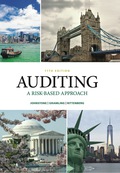
a.
Introduction: It is about the materiality as used in Accounting and Auditing To define: The Materiality as used in Accounting and Auditing, especially focusing the difference that lies between FASB and the US Supreme Court definitions of Materiality
b.
Introduction: It is about the three major dimensions of materiality.
To define: The Three major dimensions of Materiality 1) Dollar Magnitude 2) Nature of Item in consideration 3) View of a particular user.
c.
Introduction: It is about the change in the Materiality aspect during the course of audit.
To explain: The implication of changes in the Materiality aspects during Audit and the impact on the audit work already done till now.
Trending nowThis is a popular solution!

Chapter 7 Solutions
EBK AUDITING: A RISK BASED-APPROACH
- Champ Corporation bases its predetermined overhead rate on the estimated labor-hours for the upcoming year. At the beginning of the most recently completed year, the company estimated the labor-hours for the upcoming year at 75,000 labor-hours. The estimated variable manufacturing overhead was $3.50 per labor-hour, and the estimated total fixed manufacturing overhead was $2,400,000. The actual labor-hours for the year turned out to be 75,500 labor-hours. What was the predetermined overhead rate for the recently completed year closest to?arrow_forwardCan you help me solve this financial accounting question using valid financial accounting techniques?arrow_forwardCorrect answer please general accountarrow_forward
 Auditing: A Risk Based-Approach (MindTap Course L...AccountingISBN:9781337619455Author:Karla M Johnstone, Audrey A. Gramling, Larry E. RittenbergPublisher:Cengage Learning
Auditing: A Risk Based-Approach (MindTap Course L...AccountingISBN:9781337619455Author:Karla M Johnstone, Audrey A. Gramling, Larry E. RittenbergPublisher:Cengage Learning Auditing: A Risk Based-Approach to Conducting a Q...AccountingISBN:9781305080577Author:Karla M Johnstone, Audrey A. Gramling, Larry E. RittenbergPublisher:South-Western College Pub
Auditing: A Risk Based-Approach to Conducting a Q...AccountingISBN:9781305080577Author:Karla M Johnstone, Audrey A. Gramling, Larry E. RittenbergPublisher:South-Western College Pub


